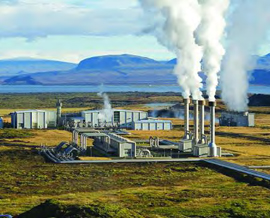Geothermal Energy
Geothermal energy comes from deep inside the Earth. It begins in the Earth's core where the temperature is about 12,632 degrees Fahrenheit (7,000 degrees Celsius). The extreme temperature heats rock and water below the surface. Some heat escapes in the form of steam and water through hot springs and geysers. Heat also escapes during volcanic eruptions.
Many countries use geothermal energy to their advantage. Iceland, for instance, pumps hot water from underground and uses it in heating systems. They warm more than 80 percent of their homes with geothermal energy! They also produce about 26 percent of their electricity in geothermal power plants.
 The Nesjavellir Geothermal Power Plant in Iceland
The Nesjavellir Geothermal Power Plant in Iceland
Using geothermal energy for hot water is an old practice. Ancient Romans built bathhouses over areas where hot water bubbled up from the ground. Many modern spas and resorts are also near natural geothermal pools.
A geothermal power plant takes the Earth's heat and converts it to electricity. California has the largest group of geothermal power plants in the world. Located north of San Francisco, The Geysers is a power complex. Twenty-two power plants sit four miles above an area of molten rock, or magma. The magma heats solid rock and water, creating steam. Drilling rigs bore holes into the earth searching for pockets of steam. Then, pipes transport the steam to turbines above. The Geysers generate clean electric power for 750,000 homes. Using more geothermal energy, and less fossil fuel energy, is another way to reduce air pollution.